Literature
Here is the talk I presented at ASLE today:

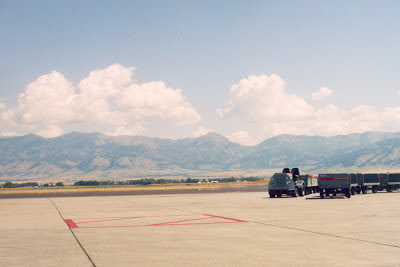
The Big Sky always presented some possibility of interference, events that could throw off the day?s scheduled flights, often with repercussions that would last for days, long hours at the computers rescheduling irate passengers.

On the other end of our routes, we were also constantly aware of the fluctuating storm cells off the Front Range that bombarded Denver International Airport nearly every afternoon. I recall one time after a massive hailstorm in Denver, when our Canadair Regional Jet arrived with hundreds of tiny dimples all over its wings, weather scars. The jets barraged by hailstones should not have been flying, according to our operation manuals?but life had to go on, the passengers were waiting, and so someone somewhere had given the go ahead for the battered planes to fly.

Of course, we more often experience airport weather at a remove, from window seats looking out, the interior noises of our aircraft muffling the elements, perhaps a few raindrops streaking across the glass.
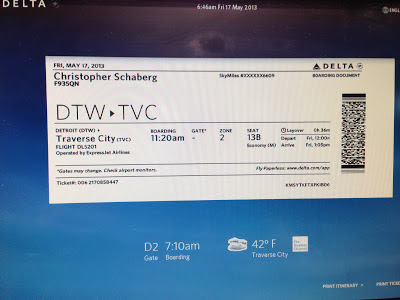
Another way we experience weather in airports comes through informational displays, streamed data in small type, miniature graphics, and semiotic cues?such as when the self-check-in kiosk tells me that it is 42 degrees at my destination airport of Traverse City, Michigan, and cloudy, as communicated through a tiny icon of clustered cumuli. Here, airport weather is embedded within an elaborate matrix of logistics including gate information, boarding time, and instructions to upgrade and print my seating assignment. The weather is one factor among so many options and data points?and yet, interestingly, it also hovers in its own almost transcendent realm, something outside the scope of the procedural operations of air travel.
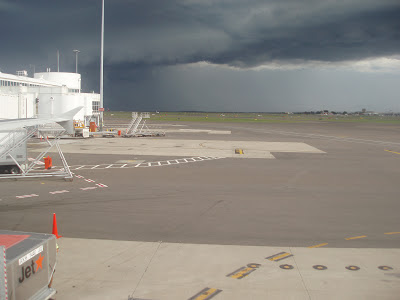
The official language in the Contract of Carriage for most airlines lumps weather under the broad category of ?conditions beyond control??or, in other words, situations that the airlines are not liable for, in the event that flights are delayed or canceled. I?m sure that most of us have had the experience of an airline representative playing the ?weather? card, by way of not having to explain fully or compensate for a missed flight, protracted delay, or unintended night in a sketchy and exorbitantly priced airport hotel.
Airport weather seems obvious, something to be avoided or at the very least skirted: an ethereal potential that lurks at the periphery of every traveler?s trip, and occasionally becomes an all-encompassing, tyrannical center point. But I wonder about the obviousness of this matter of contingency. For the bulk of this talk I want to puzzle over a few texts that overtly or tangentially take up the topic of airport weather, and in doing so to outline some aspects of this everyday phenomenon.
To begin, we will delve into the uproarious anthropomorphic world of Richard Scarry?s A Day at the Airport.

The opening pages find Huckle and Sally Cat (and Lowly Worm, of course) out for a day of sailing. But just as they get under way it begins to rain, and Father Cat tells the gang, ??There?s nothing to do but to go back home.??
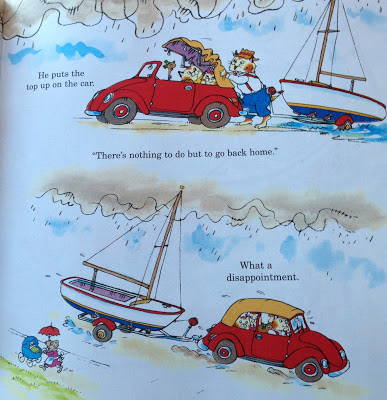
The page then editorializes, beyond the persona of any visible character, ?What a disappointment.?
This is a common enough sentiment in children?s books, noticeable also in Dr. Seuss?s classic The Cat in the Hat, where another Sally is subject to bad weather:


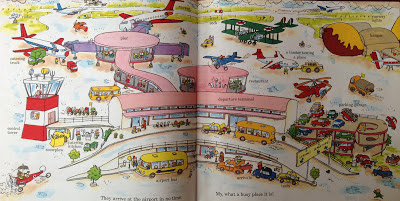




It was an ordinary day of travel, with no delays or threatening weather to speak of. The blandness of the scene was complete; and yet there was room to play, both in terms of the gathering clouds, and in my own ability to take advantage of a few minutes between flights to view a spectacle. Little did I know then, nor could I have known, the indeterminacy brewing in the Dreamliner itself, whose batteries were beginning to fail around the world, catching fire, sending smoke into cockpits and resulting in a wholesale grounding of the planes at great cost to Boeing and the airlines operating the planes. And here, the climate of air travel in general exposed a deep absurdity, wherein the Dreamliner battery packs would be fixed so as to not overheat, but would also be equipped with titanium vents in the event of unforeseen overheating. The cause of the Dreamliner battery fires remains, as of today, unknown?and yet the planes are back in the air, braving and redoubling conditions beyond control.
In this closing turn I?ve attempted to zoom out a bit, so that airport weather no longer just means precipitation, temperature, and wind. It?s the electricity and currents that run through all aspects of air travel. It?s the fun and the danger, it?s the stories and drama, the storms and the calm, the frame and the focus.
- Revisiting Bozeman
I've just returned to Michigan from Bozeman, Montana, where I revisited the airport I worked at over ten years ago. So much was the same, and yet there were also innumerable differences everywhere. I was there to observe and write, and I spent several...
- Recent Things
It has been a very busy spring, with perhaps one too many trips to the airport, even for me. My son, not yet three, can now effortlessly identify the corporate logo of Southwest (those cheery wings with a heart in the middle), delineate the various stages...
- Airport (as) Art
Airport (as) Art, Louis Armstrong International Joe Sharkey gave my book a kind mention in his column in The New York Times today, "Handy Travel Tips From Those in the Know." Joe had asked me to contribute "an actually useful air travel tip" for this...
- Pam Houston, Airplane Reader
It was in late 2003 or early 2004 when I first met Pam Houston. We were on an early morning airport run from Davis, CA to the Sacramento airport. To get from Davis to the airport, you have to hurtle across a spindly causeway that spans the swollen lowlands...
- Writing In Michigan
I am going to be in northern Michigan this summer, living in a "writing cabin" of sorts. I am working to finish a draft of my book manuscript, a revised and expanded version of my dissertation, which was entitled "Airport Reading."* I'm thinking...
Literature
Conditions Beyond Control: Airport Weather
Here is the talk I presented at ASLE today:

When I worked at the Bozeman airport in Montana, between the years of 2001 and 2003, the conditions on the tarmac could be intense: massive snow drifts or treacherous ice around the plane in the winter, cannonading thunderstorms that rolled off the Bridger Range and onto the scorching concrete in the summer.

The Big Sky always presented some possibility of interference, events that could throw off the day?s scheduled flights, often with repercussions that would last for days, long hours at the computers rescheduling irate passengers.

On the other end of our routes, we were also constantly aware of the fluctuating storm cells off the Front Range that bombarded Denver International Airport nearly every afternoon. I recall one time after a massive hailstorm in Denver, when our Canadair Regional Jet arrived with hundreds of tiny dimples all over its wings, weather scars. The jets barraged by hailstones should not have been flying, according to our operation manuals?but life had to go on, the passengers were waiting, and so someone somewhere had given the go ahead for the battered planes to fly.
Of course, we more often experience airport weather at a remove, from window seats looking out, the interior noises of our aircraft muffling the elements, perhaps a few raindrops streaking across the glass.
Another way we experience weather in airports comes through informational displays, streamed data in small type, miniature graphics, and semiotic cues?such as when the self-check-in kiosk tells me that it is 42 degrees at my destination airport of Traverse City, Michigan, and cloudy, as communicated through a tiny icon of clustered cumuli. Here, airport weather is embedded within an elaborate matrix of logistics including gate information, boarding time, and instructions to upgrade and print my seating assignment. The weather is one factor among so many options and data points?and yet, interestingly, it also hovers in its own almost transcendent realm, something outside the scope of the procedural operations of air travel.

The official language in the Contract of Carriage for most airlines lumps weather under the broad category of ?conditions beyond control??or, in other words, situations that the airlines are not liable for, in the event that flights are delayed or canceled. I?m sure that most of us have had the experience of an airline representative playing the ?weather? card, by way of not having to explain fully or compensate for a missed flight, protracted delay, or unintended night in a sketchy and exorbitantly priced airport hotel.
Airport weather seems obvious, something to be avoided or at the very least skirted: an ethereal potential that lurks at the periphery of every traveler?s trip, and occasionally becomes an all-encompassing, tyrannical center point. But I wonder about the obviousness of this matter of contingency. For the bulk of this talk I want to puzzle over a few texts that overtly or tangentially take up the topic of airport weather, and in doing so to outline some aspects of this everyday phenomenon.
To begin, we will delve into the uproarious anthropomorphic world of Richard Scarry?s A Day at the Airport.

This is a common enough sentiment in children?s books, noticeable also in Dr. Seuss?s classic The Cat in the Hat, where another Sally is subject to bad weather:

But where Dr. Seuss uses this prompt as a way to introduce the eponymous feline troublemaker, Richard Scarry comes up with another solution to the rainy day doldrums.

On their way home, the cat family stops at Scotty?s Filling Station for gas, and there they meet Rudolf Von Flugel, who comes up with a new idea: ?Why don?t they come with me? I?m going to the airport. There?s lots to see there, even when it rains!? The airport is staged as an escape from the rain, and also as a kind of exception from the bad weather: at the airport, life goes on. But there?s something a little off on these pages: Rudolf is driving his ?airplane car? (a converted propeller plane that drives backwards), and there are also small bi-planes that appear to be landing on top of Scotty?s gas pump bay. Flight, as it were, is already in the air.

A Day at the Airport proceeds to trot through all the familiar and sometimes unfamiliar operations of everyday commercial flight?and always with the looming low presence of the heavy rainclouds at the top of the page. It?s a book about airports, then, but also a book about weather, and in particular the ways that airports frame weather, or make it perceptible and navigable as such. And just as the airport frames the weather, the weather also brings an unexpected function of the airport into focus: it?s a place for play, for things to happen?thus the story is riddled with all sorts of things going awry, as cars hurtle off the parking garage, suitcases flop open all over the tarmac, and the perennially clumsy Mr. Frumble chases his errant hat around, eventually transgressing the as-if secure side of the airport.
One aspect of airport weather, then, might be play: weather is that ever-present point of slippage, of integral looseness wherein the airport?s strict functionality goes out the window, and things slide in ways that cannot always be prepared for?but might be played with.

Now let us leave the playful pages of Richard Scarry, and move on to another text, a more serious and even environmental one. Barry Lopez?s short story ?Pearyland? begins at the airport, with a drawn-out disclaimer:
I apologize for not being able to tell you the whole of this story. It begins at the airport at Søndre Strømfjord in Greenland and it happened to a man named Edward Bowman.?Pearyland? unfolds as a story quilted with ecology and spirituality; in short, it is the tale of a taphonomist who, when he ventures to the far North to study how animals get recycled into the soil, discovers that there is a quasi-religious function to this process: animals that aren?t prayed for after their deaths don?t get new bodies. Bowman has landed in a sort of purgatory where animal bodies without souls linger. Lopez?s story is haunting and deftly told, and its innuendoes about reincarnation might very well be worth heeding, in spite of their ambiguous quality.
?
About a hundred of us were waiting around for planes, his out to Copenhagen, with Søndre Strømfjord socked in. He?d been at the airport for six days; I?d been there just a few, with four Inuit friends from Clyde Inlet, on Baffin Island.
?
We were all standing by, long hours at the airport. Some people went into town, but the notion that the weather might suddenly clear for just a few minutes and a plane take off kept most of us around, sleeping in the lounges, eating at the restaurant, using the phones. (62)

In fact it is precisely this ambiguity that interests me: the rationale for Lopez?s incomplete, hazy story is housed in the airport, or rather in an airport delay. The narrator receives only part of the story, and before it can end in any fully satisfying way, the weather clears and Bowman?s plane departs. ?Pearyland? is a product of airport weather, a narrative fragment justified by its structural components. Thus another thing about airports that weather exposes is indeterminacy. When fog settles heavy over the runways, or when hail pelts and dents the wings and fuselage of planes, the indeterminate status of things is exposed?the fabric isn?t so seamless, and stories can get interrupted and ambiguous. As much as these spaces depend on strict schedules, careful predictions, and secure borders, airports also revel in the contingencies of weather: the arrested journey, the punctuated or obscured landscape, the story that is both made possible by dense fog, and cut short by its sudden lifting.

The second chapter of David Foster Wallace?s unfinished novel The Pale King lends another fragment of the airport weather imaginary. In this section we meet the hyper-aware character Claude Sylvanshine, a ?fact psychic,? who is en route to Peoria, Illinois to take his CPA exam. (The larger novel is about IRS workers and their daily career grind.) Sylvanshine is introduced while onboard a fifty-minute commuter flight from Chicago to Peoria, Illinois, and his observations from his cramped seat amount to a scathing critique of the culture of flight (and late capitalism in general). Most useful for our purposes here, though, is a passage toward the end of the section, as Sylvanshine?s mundane journey comes to a close:
They deplaned and descended and collected the carry-on bags that had been confiscated and tagged at Midway and now rested in a motley row on the wet tarmac beside the airplane, and stood then briefly en masse on a complexly painted cement expanse while someone with orange earmuffs and clipboard counted them and then crosschecked with a previous count undertaken at Midway. The whole operation seemed somewhat ad hoc and slapdash.This section in Wallace?s story is about an utterly unremarkable trip, and ordinary adventure that goes off without a hitch?and yet which is haunted by a vague sense of being ?ad hoc and slapdash.? The bland weather here??The wind was warm and steamy??functions as a curious remark on the bland ?operation? as a whole. It is something that has no charm, no magic, no drama?or rather, all the drama is internal, perhaps even latent. Earlier in the chapter, in-flight, Sylvanshine observes small raindrops beading on the aircraft window as the plane rocks back and forth above a superhighway; it?s all standard operating procedure, but he?s intensely aware of everything.
?
The wind was warm and steamy. A large hose extended from a small truck to the commuter plane?s stomach and appeared to be refueling the craft for its turnaround to Chicago. Up and back again and again all day. There was a strong scent of fuel and wet cement. (20)

Wallace embeds a kind of eerie existential dread just beneath the veneer of a humdrum commuter flight, wherein everything is operating more or less normally, and yet it?s also all a little freaky, including the unremarkable weather that is nevertheless noted. Wallace reminds us how airport weather is supposed to be unnoticeable, should fade into the muted background of a normal travel day (or night). But the normal atmosphere of flight itself can become weirdly heavy, inducing strange perceptions and even a kind of overwhelming terror. Airport weather isn?t just about the weather. It?s about a whole swarm of actions and things taking place in this manufactured landscape.
Here is how Sylvanshine ends his tarmac meditation:
 In her book Ordinary Affects, the anthropologist Kathleen Stewart uses a scene spawned by airport weather as an example of ?a contact zone for analysis? (5). Stewart?s larger project in this book is to map the everyday yet haunting surface of interactions and tension points in contemporary American culture, enacting a heuristic for recording and gauging what she calls ?ordinary affects.?
In her book Ordinary Affects, the anthropologist Kathleen Stewart uses a scene spawned by airport weather as an example of ?a contact zone for analysis? (5). Stewart?s larger project in this book is to map the everyday yet haunting surface of interactions and tension points in contemporary American culture, enacting a heuristic for recording and gauging what she calls ?ordinary affects.?
In the section ?A Raindrop Falls in Houston,? Stewart describes a routine flight to Austin via Houston, which gets interrupted when ?the pilot announces that there has been heavy rain in the Houston area. The new air traffic control tower has flooded (there?s a flaw in the design), and they have shut down the airport. Her plane is short on fuel, so it?s diverted to Austin? (89). But in a Kafkaesque scene of technicalities and elaborate structural contradictions, Stewart is not able to leave the plane in Austin (her actual destination), and instead must sit on the plane for nine hours on the runway, after which point she is flown back to Houston, only then to face an abject layover and seemingly endless lines at the airport the next day, the ripple effect of mass cancellations.
At one point during the initial botched reroute, Stewart reports, without commentary, ?The pilot announces that there is no plan? (90). Stewart closes the case study this way: ?The next morning the news reports that Houston airport is back to normal, and we try to forget, as if nothing happened. Just move on? (90).
For Stewart airport weather seems to promise nothing less than a kind of radical break in progress, for the sake of progress. Airport protocols around weather spark a surge of sheer irrationality; yet it is a surge that, with effort, can be forgotten and absorbed back into the mainstream. Conditions beyond control have a way of infiltrating and infecting the most mundane and normally functional routines of flight, and these infiltrations and infections must then be dynamically repressed...or simply smoothed over.
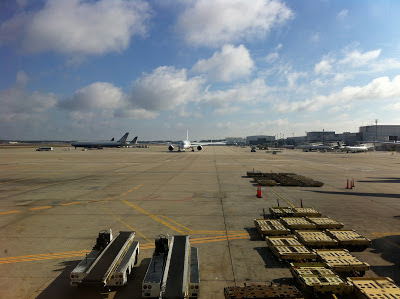
I want to close today with my own Houston story, a story triggered by a photograph I snapped this past January, as I was flying back home to New Orleans from Boston. I had hoped to catch a glimpse of the new Boeing Dreamliner on my trip, and sure enough, as I was racing to make my connection in Houston, I spotted a United Airlines Dreamliner preparing for departure. In a quick detour, I shot down an escalator and sprinted down the concourse in time to see the pushback and hear the low revving thrum of the engines, and to watch the Dreamliner lumber off toward the runway.
Here is how Sylvanshine ends his tarmac meditation:
?on the wet tarmac surrounded by restive breathers, turning 360° several times and trying to merge his own awareness with the panoramic vista, which except for airport-related items was uniformly featureless and old-coin gray and so remarkably flat that it was as if the earth here had been stamped on with some cosmic boot, visibility in all directions limited only by the horizon, which was the same general color of the sky and created the specular impression of being in the center of some huge and stagnant body of water, an oceanic impression so literally obliterating that Sylvanshine was cast or propelled back in on himself and felt again the edge of the shadow of the wing of Total Terror... (24)Nothing eventful has happened here, and yet?something is emerging.

In the section ?A Raindrop Falls in Houston,? Stewart describes a routine flight to Austin via Houston, which gets interrupted when ?the pilot announces that there has been heavy rain in the Houston area. The new air traffic control tower has flooded (there?s a flaw in the design), and they have shut down the airport. Her plane is short on fuel, so it?s diverted to Austin? (89). But in a Kafkaesque scene of technicalities and elaborate structural contradictions, Stewart is not able to leave the plane in Austin (her actual destination), and instead must sit on the plane for nine hours on the runway, after which point she is flown back to Houston, only then to face an abject layover and seemingly endless lines at the airport the next day, the ripple effect of mass cancellations.
At one point during the initial botched reroute, Stewart reports, without commentary, ?The pilot announces that there is no plan? (90). Stewart closes the case study this way: ?The next morning the news reports that Houston airport is back to normal, and we try to forget, as if nothing happened. Just move on? (90).
For Stewart airport weather seems to promise nothing less than a kind of radical break in progress, for the sake of progress. Airport protocols around weather spark a surge of sheer irrationality; yet it is a surge that, with effort, can be forgotten and absorbed back into the mainstream. Conditions beyond control have a way of infiltrating and infecting the most mundane and normally functional routines of flight, and these infiltrations and infections must then be dynamically repressed...or simply smoothed over.
I want to close today with my own Houston story, a story triggered by a photograph I snapped this past January, as I was flying back home to New Orleans from Boston. I had hoped to catch a glimpse of the new Boeing Dreamliner on my trip, and sure enough, as I was racing to make my connection in Houston, I spotted a United Airlines Dreamliner preparing for departure. In a quick detour, I shot down an escalator and sprinted down the concourse in time to see the pushback and hear the low revving thrum of the engines, and to watch the Dreamliner lumber off toward the runway.
It was an ordinary day of travel, with no delays or threatening weather to speak of. The blandness of the scene was complete; and yet there was room to play, both in terms of the gathering clouds, and in my own ability to take advantage of a few minutes between flights to view a spectacle. Little did I know then, nor could I have known, the indeterminacy brewing in the Dreamliner itself, whose batteries were beginning to fail around the world, catching fire, sending smoke into cockpits and resulting in a wholesale grounding of the planes at great cost to Boeing and the airlines operating the planes. And here, the climate of air travel in general exposed a deep absurdity, wherein the Dreamliner battery packs would be fixed so as to not overheat, but would also be equipped with titanium vents in the event of unforeseen overheating. The cause of the Dreamliner battery fires remains, as of today, unknown?and yet the planes are back in the air, braving and redoubling conditions beyond control.
In this closing turn I?ve attempted to zoom out a bit, so that airport weather no longer just means precipitation, temperature, and wind. It?s the electricity and currents that run through all aspects of air travel. It?s the fun and the danger, it?s the stories and drama, the storms and the calm, the frame and the focus.
- Revisiting Bozeman
I've just returned to Michigan from Bozeman, Montana, where I revisited the airport I worked at over ten years ago. So much was the same, and yet there were also innumerable differences everywhere. I was there to observe and write, and I spent several...
- Recent Things
It has been a very busy spring, with perhaps one too many trips to the airport, even for me. My son, not yet three, can now effortlessly identify the corporate logo of Southwest (those cheery wings with a heart in the middle), delineate the various stages...
- Airport (as) Art
Airport (as) Art, Louis Armstrong International Joe Sharkey gave my book a kind mention in his column in The New York Times today, "Handy Travel Tips From Those in the Know." Joe had asked me to contribute "an actually useful air travel tip" for this...
- Pam Houston, Airplane Reader
It was in late 2003 or early 2004 when I first met Pam Houston. We were on an early morning airport run from Davis, CA to the Sacramento airport. To get from Davis to the airport, you have to hurtle across a spindly causeway that spans the swollen lowlands...
- Writing In Michigan
I am going to be in northern Michigan this summer, living in a "writing cabin" of sorts. I am working to finish a draft of my book manuscript, a revised and expanded version of my dissertation, which was entitled "Airport Reading."* I'm thinking...
